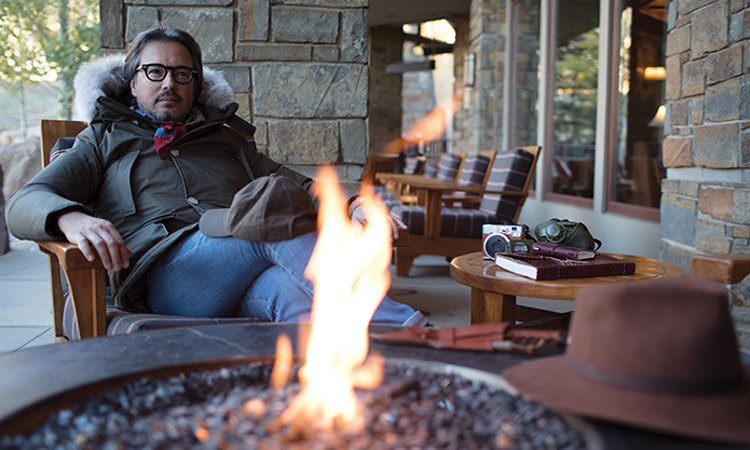
Montblanc mountain adventures
“Day & Night” magazine caught up with Davide Cerrato, Managing Director of Montblanc International Watch Division, on the side lines of the marque’s annual adventure – at Jackson Hole, Wyoming, USA
Why was Jackson Hole chosen in 2017 for the Montblanc adventure?
We are here in Jackson Hole, Wyoming, USA to celebrate the spirit of exploration as this year we are presenting a full reprisal of our 1858 collection, which is built around the concept of mountain exploration. We feel that this is the perfect place to speak about it – the great outdoors, symbolising the American ideal of the real wildlife country, the Rocky Mountains with its wonderful views and amazing real-life contact with the wildlife.
When did you develop the idea of mountain adventure and wildlife?
At the very beginning of conceiving a collection, we decide the theme. We are Montblanc; the brand is named after one of the tallest mountains in Europe. It is the perfect symbol of exploration, the big outdoors, and the challenges of going beyond your limits. The 1858 Collection – a line of vintage, military-inspired watches celebrates this spirit of adventure.
Is there any possibility of merging the Minerva collection and the regular collection?
Definitely yes; Minerva is Montblanc and Montblanc is Minerva. Minerva is part of our patrimony and our asset. We are now leveraging it at full speed, and are using it in all our products at many levels. Minerva has a history and heritage of fantastic watches. In the case of 1858, we took a close look at the military watches of the 1930s and 40s, which inspired our contemporary designs that are consistent and strong making for watchmaking with character, which is our positioning as a brand.
Both Minerva and Montblanc have a tradition of rich and strong storytelling, and we can now build up each of our collections from the knowledge we gain from Minerva. In this case especially, we have used Minerva’s fantastic movement, the Chronograph Monopushers.
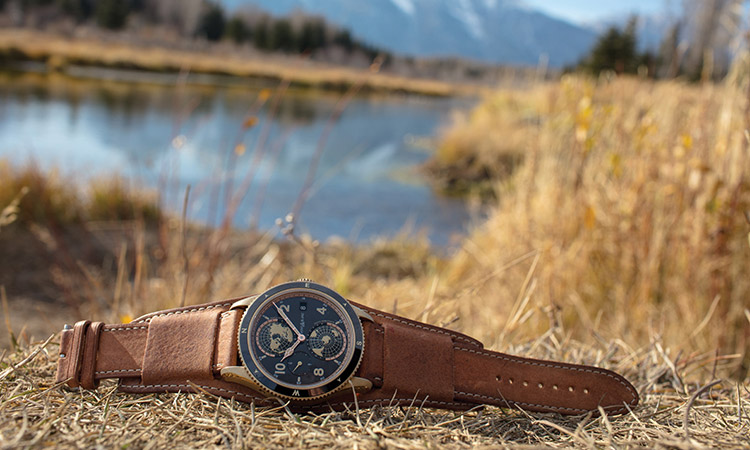
Why is it that Montblanc is the only brand that still gives a lot of importance to pocket watches?
We feel that pocket watches comprise a segment in the market where there is a real need; we try to fulfil that lacuna. Pocket watches are an important part of Minerva’s history – both in the earlier days of the 20th century when pocket watches were popular and also recently when Minerva focused on the stop watches and counters. Montblanc is not planning to just reissue the old pocket watches; we are thinking of versatility, and a creative and enjoyable ways of wearing a watch, which is becoming one of Montblanc’s signature touches. We played on this at the rally time last year, when we demonstrated a pocket watch as something you can wear on your wrist, put on your table, and put on the dashboard of your classic car. We are now pushing the theme forward with our pocket watch and mountain exploration concept.
Why is Montblanc so fascinated with the Chrono Monopusher?
This complication is the very heart of the Minerva marque; it all started in 1909 with the very first monopusher movement. In the 1920s, Minerva released the second one, the smaller 13 lignes 1320; in the 1930s, Minerva, in its military watches, produced the 17 lignes chrono monopusher – the 1729. We are now using it with both the 1629 Chrono Monopusher and all the 1858 models. This year, we have added the 1321, which is a very nice one in 13 lignes that is housed in one of the high-end watches in 40 mm steel of the 1858 collection.
Can you tell us more about the movement, which is hidden and not visible through the case back?
It looks very special, all the chronograph monopushers are completely made and finished in Villeret – totally in house – the finishings showcase the high-end mastery of traditional watchmaking skills. The movement is absolutely incredible; 18,000 vph with a very big balance wheel and very sophisticated finishing that though hidden from sight is what traditional watchmaking is all about.
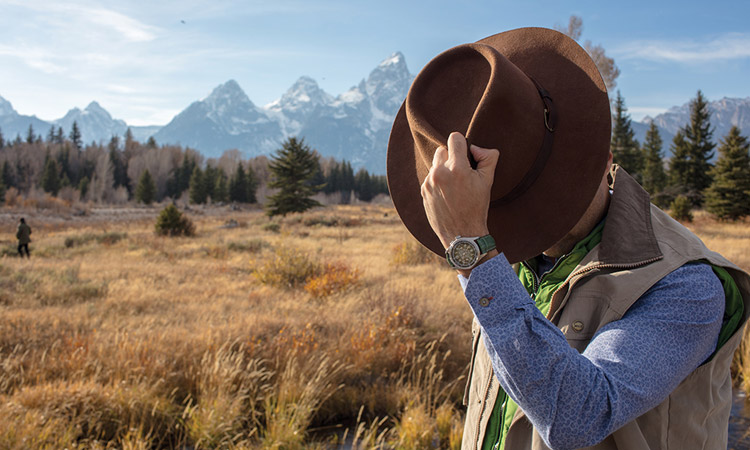
Can you tell us your process for designing a watch?
Our process is not so different from what other brands do; what is unique to Montblanc is that it begins with a narrative, a creative concept. This creative concept then drives a lot of the choices made during the processes of product development, design, development of communication, and the product itself. In a parallel manner, it allows us to have a consistency that is very strong. Once you look at the concept – in this case, of mountain exploration – and you then look at the watch, you see a lot of different details that match the concept and proves that when we are talking about the great outdoors and exploration, it is not just a marketing technique and we are just describing the true spirit that was in play in our choice of vintage straps, the vintage-style dial, the glass box dome, the details engraved on the case back, etc.
How hard was it to get the green colour on your latest 40 mm chronograph monopusher with green sun ray dial, which is such a vibrant shade?
At Montblanc, we are perpetually looking for new styles and material that can become brand icons. One such venture is research on dials; we found a very original take on sun-ray champagne dials, but we are planning it in different colours. We are playing a lot on the richness and depth of colours, and we used that first on the 1858 bronze with the champagne sun-ray dial that matches the colour of the bronze perfectly. We pushed it a bit further in our 1858 Chronograph Tachymeter Only Watch 2017, in which we used what we call the ‘vintage British green’; in this you find not only the sun-ray effect but also the gradation of colours, so that the edges of the dial are darker than the centre of the dial, which adds incredible depth to it.
So, in our latest 1321 Chrono Monopusher in 40 mm steel edition, we are using the same technique by matching this green with an alligator strap in the same green, with the sfumato effect. We are also using this on a new watch that we are now offering: another execution in bronze with a salmon-pink dial that is evocative of the 1920s and the 1930s, with blue hands. The dial has the same incredible depth and richness of colour as do the champagne dials.
What are the main pillars of the Montblanc watch division?
The most important one is that our way of making watches with character, which is now our watchmaking statement. We are now working on bringing in at every stage, a high level of personality, of character, of emotion, of expression, and of detail, thus in the end, offering pleasure to our clients by doing this. We are also building up our collection on two main pillars, the ExoTourbillon and the Chronograph Monopusher.
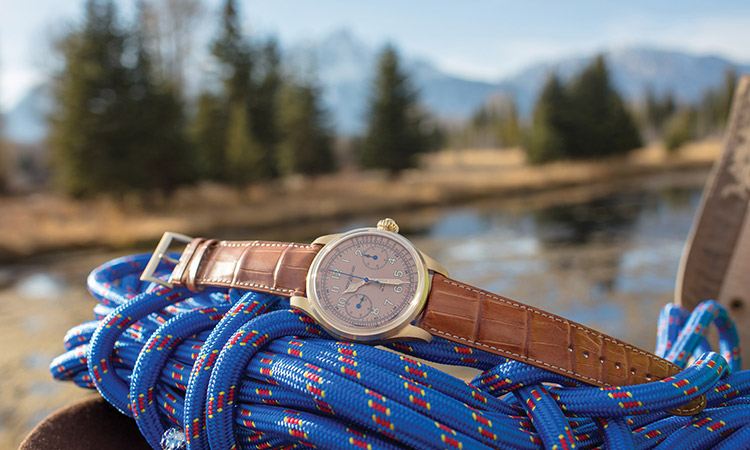
How do you manage to maintain the balance of your appeal to both the older and the younger generations with your new collection?
We are now building up our professional sport offerings in a strong manner; we have our Nicolas Rieussec Rising Hours Chronograph Watches, we are now adding a vintage-explorer look and feel to our 1858 collection. Our 1858 collection reflects the concept of mountain exploration and outdoor adventure that we believe in strongly. Our brand name Montblanc, and our heritage legitimises us when we speak of this; also this concept is very transversal and inspirational, and appeals to the millennials.
If you look at Instagram, for instance, you can see numerous accounts with names such as ‘Outbound camp’, where millennials are focusing a lot more on camping, the outdoors, and dream of living in the wild, have adventures, and get in touch with nature; this is very contemporary and also very inspirational.
How do you ensure that the adventure continues throughout the year with the 1858 collection?
We are now setting up product lines that are meant to stay for a very long time. That is why for the TimeWalker we have set up a partnership with the Goodwood Festival of Speed for five years. Here, we have brought over a great explorer, Mr Kenton Cool, who has climbed Mount Everest 12 times. We plan to bring in more adventure stories so that we can keep the concept and the story alive for a long time, with clever intelligent twists so that the bond between our customers and the 1858 line remains strong.
How important are straps to Montblanc as in your watches, the strap is usually designed as an integral part of the watch and not an afterthought?
The pleasure of wearing watches is one of the key pillars of our development. Thanks to our leather manufacturing unit in Florence, we have been working on a very nice vintage treatment for our leather straps – a unique manual treatment that we call ‘sfumato’, where the external edges of the strap are darker than the internal part. We are playing with different original straps such as the band strap that we offer in our 1858 collection. We are now adding particular styles of NATO straps with traditional weaving done in the east of France with a sophisticated finishing. These are highly resistant to wear and come in original patterns and texture.
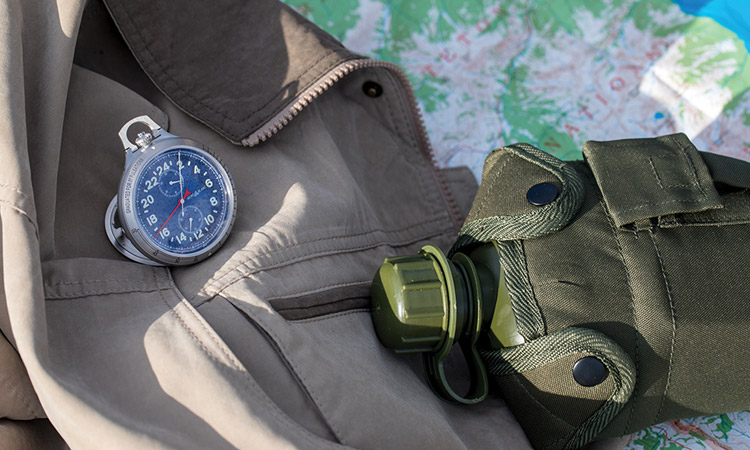
Would Montblanc be using the Hemisphere watch strap for the other watches also or not?
We will be using it more and more; we already have started using it for TimeWalker with a band strap in black matt alligator. We are also using it with an aged, distressed look for the 1858, and we will add the band strap as one of the possible choices in our straps on offer.
Would the Montblanc boutiques have a separate section for straps in the future?
Definitely yes; from the beginning of this year, we are going to offer a comprehensive choice of straps that will include our leather vintage sfumato straps, our incredibly detailed handcrafted NATO straps, and our band straps that add an additional layer of pleasure to the wearing of our watches.
Would you like to say anything to the Montblanc watch aficionados?
Please join us in the wild, the great American outdoors, in the pleasure of adventure, of vintage military watches and the use of bronze, and the multi-time zone complication that we are bringing into the market, which I am sure will be another iconic collector’s item and a winner for Montblanc.






